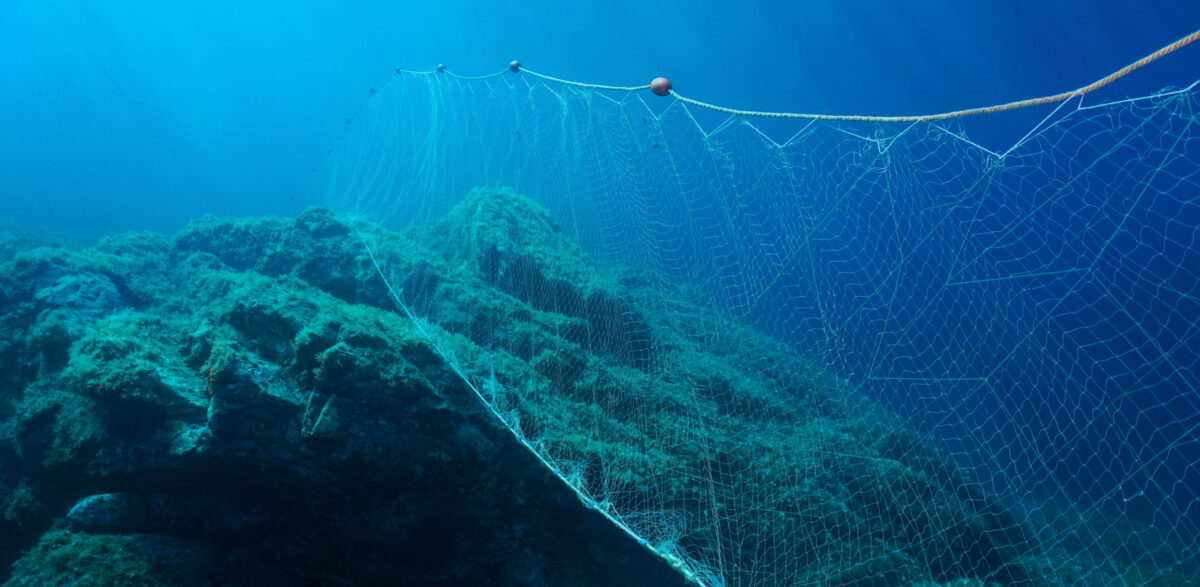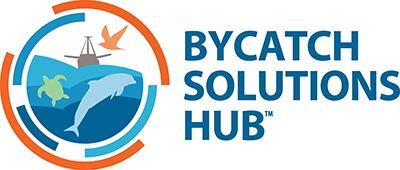Gear Types
Gillnets
Gillnets are large nets that hang vertically in the water designed to entangle most things that swim into them.
Either attached to buoys and left to drift or anchored to the seafloor, gillnets are designed to catch and kill indiscriminately. Although some size selection can be achieved through altering the size of the holes in the gillnets, anything that does not fit through the gaps can easily become caught. This can lead to significant bycatch issues, as gillnets are non-selective, difficult to see, and often used in areas with high densities of all four ETP taxa.

A gillnet set over a hardbottom area of the seafloot.
Since gillnets are designed to be difficult to see and non-selective, and are often set in areas with high densities of all four ETP taxa, they can account for staggering amounts of bycatch. When entangled, most animals will struggle to get out and become increasingly wrapped up in the net. When trapped underwater, air-breathing animals, such as mammals, sea turtles, and seabirds, will eventually drown.
If nets are lost, they will drift and continue to catch fish and other species, posing an additional bycatch threat as ghost gear. Deploying tracking buoys on the nets can avoid this risk and ensure that lost gear can be recovered.
ETP Impacts and Fishery Recommendations
- Transition to alternative gear types effective for the target species.
- Restrict fishing in regions and times of the year with high bycatch rates.
- Limit the soak time of gillnets to decrease time that bycatch is entangled.
- Deploy acoustic pingers regularly along gillnets.
- Provide best methods handling-and-release training to the captain and crew.
- Require 100% coverage on all fishing vessels – through a combination of human observer and electronic monitoring – with detailed bycatch data collection.
- Ensure 100% compliance with all management measures specific to marine mammals, both at the country and management-organization level.
- Transition to alternative gear types effective for the fishery.
- Restrict fishing in regions and times of the year with high bycatch rates, especially where fishing overlaps with nesting sites.
- Set gillnets so the float line is a few meters below the surface.
- Require the use of net lights in areas with documented bycatch.
- Provide best methods handling-and-release training to the captain and crew.
- Set a tracking device on all gillnets, with initial emphasis on driftnets, so nets can be tracked and recovered if lost.
- Require 100% coverage on all fishing vessels – through a combination of human observer and electronic monitoring – with detailed bycatch data collection.
- Ensure 100% compliance with all management measures specific to sea turtles, both at the country and management-organization level.
- Transition to alternative gear types effective for the fishery.
- Restrict fishing in regions and times of the year with high bycatch rates, especially where fishing overlaps with albatross and petrel populations in temperate and polar seas.
- Set gillnets at a minimum depth of 20 m.
- Provide best methods handling-and-release training to the captain and crew.
- Set a tracking device on all gillnets, with initial emphasis on driftnets, so nets can be tracked and recovered if lost.
- Require 100% coverage on all fishing vessels – through a combination of human observer and electronic monitoring – with detailed bycatch data collection.
- Ensure 100% compliance with all management measures specific to seabirds, both at the country and management-organization level.
- Transition to alternative gear types effective for the fishery.
- Restrict fishing in regions and times of the year with high bycatch rates.
- Limit the soak time of the gillnet to decrease time that sharks are entangled.
- Require 100% coverage on all fishing vessels – through a combination of human observer and electronic monitoring – with detailed bycatch data collection.
- Ensure 100% compliance with all management measures specific to sharks and rays, both at the country and management-organization level.
Marine mammals can become entangled in gillnets and eventually drown if they can’t surface for air. Acoustic pingers and underwater lights, which are required by some management authorities, are currently the best tools to decrease dolphin and porpoise bycatch rates. However, they do not fully eliminate bycatch, and therefore the recommended practice is a transition to more selective fishing methods. Other best practices include setting the net lower in the water column, limiting soak times (nets hauled more often), and enacting strong spatial and temporal closures when bycatch risk is highest.
General Recommendations
Sea turtles can swim into gillnets and become entangled and drown. Pelagic gillnets overlap with migratory juveniles, while coastal gillnets can catch large numbers of nesting females during the egg-laying season. The best way to mitigate sea turtle bycatch is to close fishing in hot spots and near nesting beaches. Using net lights and lowering the float line can decrease sea turtle bycatch rates, but do not eliminate them.
General Recommendations
Diving seabirds that feed on fish entangled in gillnets can become entangled themselves and drown. To mitigate seabird entanglement, gillnets should be set a minimum of 10 meters below the surface, with a target depth of 20 meters if possible. The only way to decrease mortality rates for entangled seabirds is to decrease the “soak” time, so that seabirds can be released before they drown.
General Recommendations
Sharks and rays can easily become entangled in gillnets, resulting in very high mortality rates. Gillnets are designed to entangle fish, and sharks are attracted to the trapped fish. Entangled sharks will drown, since they can no longer pump water over their gills. To mitigate bycatch rates, gillnets should not be set in shark and ray hotspots or areas with vulnerable populations. The best mitigation measure is transitioning to a gear type with lower impacts.
General Recommendations
